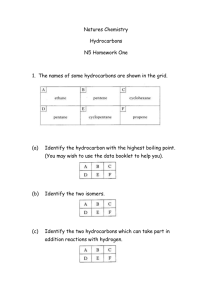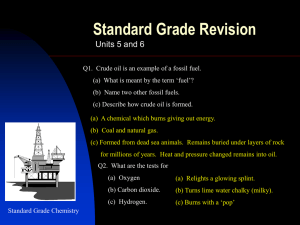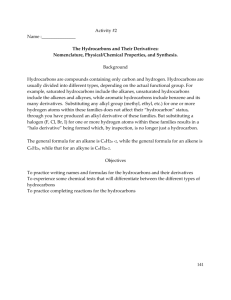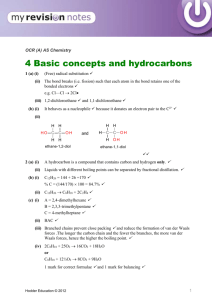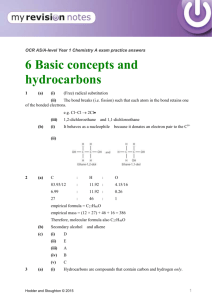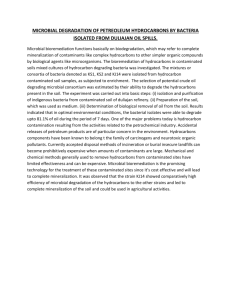Chemistry of Hydrocarbons
advertisement
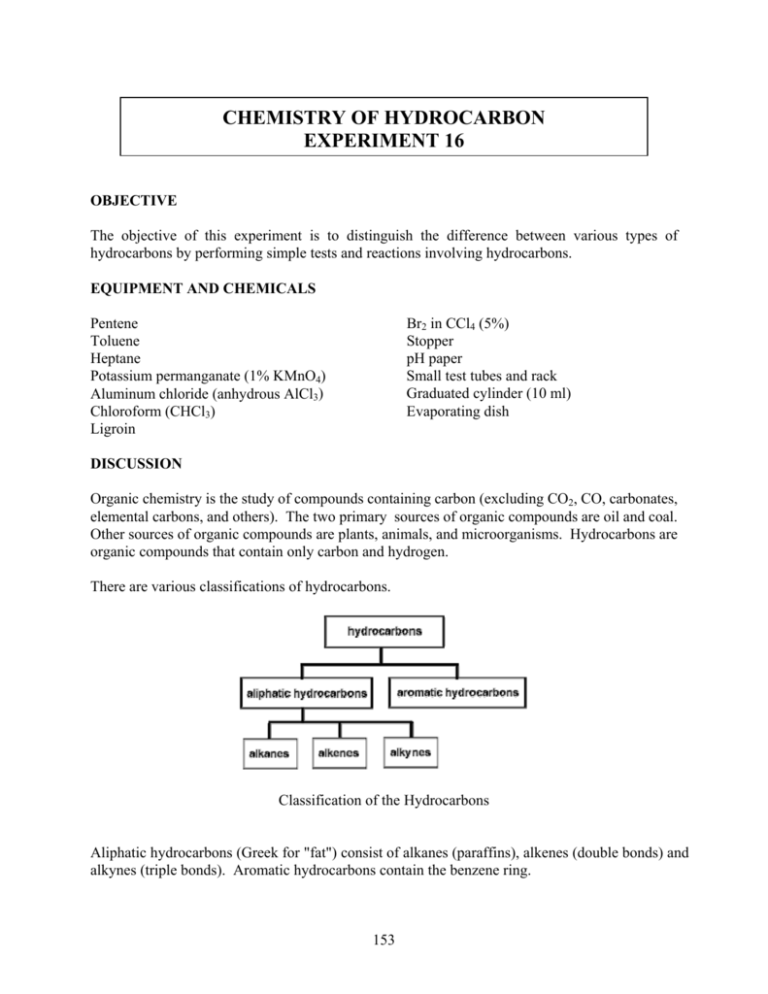
CHEMISTRY OF HYDROCARBON EXPERIMENT 16 OBJECTIVE The objective of this experiment is to distinguish the difference between various types of hydrocarbons by performing simple tests and reactions involving hydrocarbons. EQUIPMENT AND CHEMICALS Pentene Toluene Heptane Potassium permanganate (1% KMnO4) Aluminum chloride (anhydrous AlCl3) Chloroform (CHCl3) Ligroin Br2 in CCl4 (5%) Stopper pH paper Small test tubes and rack Graduated cylinder (10 ml) Evaporating dish DISCUSSION Organic chemistry is the study of compounds containing carbon (excluding CO2, CO, carbonates, elemental carbons, and others). The two primary sources of organic compounds are oil and coal. Other sources of organic compounds are plants, animals, and microorganisms. Hydrocarbons are organic compounds that contain only carbon and hydrogen. There are various classifications of hydrocarbons. Classification of the Hydrocarbons Aliphatic hydrocarbons (Greek for "fat") consist of alkanes (paraffins), alkenes (double bonds) and alkynes (triple bonds). Aromatic hydrocarbons contain the benzene ring. 153 C C C alkane alkene C C C alkyne benzene Hydrocarbons can be further divided into saturated hydrocarbons that have only single carbon-carbon bonds (alkanes), and unsaturated hydrocarbons that have multiple carbon-carbon bonds (alkenes, alkynes, aromatics). Most of the aliphatic compounds are named based on the first ten alkanes (Table 14-1). As a rule, hydrocarbons with names ending in -ANE are alkanes, -ENE are alkenes, and -YNE are alkynes. Name Molecular Formula methane ethane propane butane pentane hexane heptane octane nonane decane Carbons 1 2 3 4 5 6 7 8 9 10 CH4 C2H6 C3H8 C4H10 C5H12 C6H12 C7H16 C8H18 C9H20 C10H22 Alkane Series For example, if a hydrocarbon had four carbons with no multiple bonds, it would be named butane (saturated). If the compound had a double bond, it would be named butene (unsaturated), or a triple bond as butyne (unsaturated). The various classes of hydrocarbons can be distinguished from each other by the types of reactions they undergo. In other words, alkanes react differently than aromatics, alkenes, and alkynes under the same conditions. The various hydrocarbons also have different physical properties. Hydrocarbons are very non-polar and will only dissolve in similarly non-polar solvents (like dissolves like). Water is a polar solvent while ligroin (a mixture of saturated alkanes) is non-polar. Therefore, the hydrocarbons would tend to dissolve in ligroin or other non-polar solvents (for example CCl4) rather than polar solvents (water). REACTIONS OF ALKANES Alkanes are relatively inert (do not react). The most common type of reaction they undergo is the reaction with oxygen. Gasoline and heating fuels are mixtures of alkanes which when combined with oxygen given off heat and light. CH 4 + 2 O2 → CO 2 (excess) 154 + 2 H2 O + energy If the oxygen content is limited, the hydrocarbons do not burn efficiently. In addition to producing carbon dioxide and water, the hydrocarbons will also give off carbon monoxide (CO - a poisonous gas) and elemental carbon (soot). CH 4 + → 2 O2 C + CO + CO 2 + + H2 O energy (lim ited) Alkanes can be identified using bromine dissolved in CCl4. The dissolved bromine (Br2) is a brown liquid and the disappearance of the brown colour indicates a reaction has taken place. Alkenes and alkynes also react with bromine in CCl4 but their reactions are rapid while the alkane requires light and is very slow. Aromatics do not react at all with bromine under these conditions. H H R H C + Br2 uv R C Br + HBr H H Since the reaction is so slow, the disappearance of the brown colour may be hard to observe. A method to check to see if the reaction is taking place is to place pH paper near the surface of the reaction. If any HBr gas (acidic) is being given off, it will change the blue litmus paper to red. This type of reaction is called a substitution reaction since the bromine is being substituted for the hydrogen. REACTIONS OF ALKENES AND ALKYNES Alkenes and alkynes both have very reactive multiple carbon bonds and behave similarly in most reactions. Usually, the triple bond is changed to a double bond and the resulting compound reacts as an alkene. Alkenes can be distinguished from alkanes and aromatic hydrocarbons by their rapid reaction with bromine in CCl4. The aromatic compounds do not react, while the alkane is very slow. The alkenes do not need light to react with bromine C C + Br2 C C Br Br Evidence of a reaction is the disappearance of the brown colour of the bromine in CCl4. It should also be noted that no acidic gas is given off. This type of reaction is called an addition reaction because the bromine is being added to the chain. An additional test to determine whether or not a compound is an unsaturated hydrocarbon is known as the Baeyer Test. Potassium permanganate (KMnO4) is purple. When added to an unsaturated hydrocarbon, the purple colour will change to a brown colour (MnO2) that indicates a reaction has taken place. 155 REACTION OF AROMATICS Aromatic compounds will react with anhydrous aluminum chloride (AlCl3) in chloroform (CHCl3) to produce brightly coloured mixtures. This type of test is known as a Friedel-Crafts reaction. The aliphatic compounds give either no colour or a pale yellow colour. PROCEDURE PART A - SOLUBILITY OF HYDROCARBONS The solubility of pentene, toluene, heptane, and an unknown will be tested in various solvents. 1. Put 5 ml of water (a polar solvent) into four different small test tubes. Label each test tube as pentene, toluene, heptane, or unknown. 2. Add 1 ml of each hydrocarbon to their respective test tubes. Stopper and shake. 3. The absence of two distinct liquid layers indicates solubility (a cloudy appearance indicates insolubility). Record your observations on the Report Sheet. 4. Add 5 ml of ligroin (non-polar solvent made of saturated hydrocarbons) to four additional small test tubes. 5. Add 1 ml of each hydrocarbon to its respective test tube. Stopper and shake. Record your observations on the Report Sheet. 6. Remember the old saying - like dissolves like. PART B - FLAMMABILITY OF HYDROCARBONS The combustion of the heptane, pentene, toluene, and an unknown with oxygen will be observed. 1. Place 1 ml of heptane in an evaporating dish and ignite with a burning wood splint. Record your observations on the Report Sheet. 2. Place 1 ml of pentene in an evaporating dish and ignite. record your observations on the Report Sheet. 3. Place 1 ml of toluene in an evaporating dish and ignite. Record your observations on the Report Sheet. 4. Place 1 ml of unknown in an evaporating dish and ignite. Record your observations on the Report Sheet. 156 PART C - REACTION OF HYDROCARBONS WITH BROMINE The reaction of pentene, heptane, toluene, and an unknown with bromine will be observed. Bromine is brownish and the disappearance of the brown from a reaction mixture indicates a reaction is taking place (positive test). 1. Clean and dry four small tubes. 2. Place 1 ml of pentene in the first test tube, 1 ml heptane in the second test tube, 1 ml of toluene in the third test tube, and 1 ml of the unknown in the fourth test tube. 3. Carry out this next step in a fume hood. 4. Add 4 drops of 5% bromine in CCl4 to each test tube and gently swirl the contents of the tubes. 5. Every 30 seconds place a piece of moistened blue litmus paper to the lip of each test tube and blow gently into the test tube. If the blue changes to red, it indicates the presence of HBr being given off in the reaction. Report your results on the Report Sheet. 6. Observe any colour changes and the speed of the changes for five minutes. Record these observations on your Report Sheet. PART D - REACTION OF HYDROCARBONS WITH POTASSIUM PERMANAGANATE Potassium permanganate (KMO4) is an oxidizer. KMO4 is a purple coloured compound. If the KMnO4 reacts with the hydrocarbon, a brown colour will be observed (MnO2). This is known as the Baeyer Test for unsaturation. 1. Place 1 ml of each of the hydrocarbons (heptane, pentene, toluene, and the unknown) into separate clean and dry small test tubes. 2. Add 3 drops of 1% aqueous KMnO4 to each test tube, swirl gently, and let stand. 3. Record your observations on the Report Sheet. 157 PART E - REACTION OF HYDROCARBONS WITH ALUMINUM CHLORIDE The reaction of aromatic hydrocarbons with aluminum chloride (AlCl3) and chloroform (CHCl3) to produce a brightly coloured compound is known as a Friedel-Crafts reaction. 1. Place 2 ml of CHCl3 into four separate clean and dry small test tubes. 2. Add two drops of pentene to one test tube, two drops of heptane to the second test tube, two drops of toluene to the third test tube, and two drops of the unknown to the fourth test tube, and gently swirl each test tube. 3. Incline each test tube to moisten the wall and add 0.5 gm of AlCl3 so that some of the solid strikes the side of the moisten test tube wall. 4. Record your observations on the Report Sheet. Friedel-Craft Reaction PART F - IDENTIFICATION OF AN UNKNOWN HYDROCARBON Record your unknown number and observations on the Report Sheet. 158 Name ____________________ Date _____________________ Section ___________________ CHEMISTRY OF HYDROCARBONS REPORT SHEET EXPERIMENT 16 SOLUBILITY OF HYDROCARBONS 1. Which hydrocarbons were soluble in water? 2. Which hydrocarbons were soluble in ligroin? 3. Ligroin, which is a combination of saturated hydrocarbons, only dissolves what type of hydrocarbons? Remember "like dissolves like." 4. Fill out the following table using "l" for insoluble and "S" for soluble. Hydrocarbons Water Heptane Pentene Toluene Unknown FLAMMABILITY OF HYDROCARBONS 1. Describe the colour and characteristics of the heptane flame. 2. Describe the colour and characteristics of the pentene flame. 3. Describe the colour and characteristics of the toluene flame. 159 Ligroin REACTION OF HYDROCARBONS WITH BROMINE Complete the following table using "R" to indicate a reaction, "NR" to indicate no reaction, "F" for a fast reaction, and "S" for a slow reaction. Hydrocarbon Reaction (R or NR) Litmus (Y or N) Time to React (F or S) Heptane Pentene Toluene Unknown 1. 2. a) What reaction occurs (if any) when heptane is mixed with Br2? Describe your results and give the equation. b) What test indicates an alkane? a) What reaction occurs (if any) when pentene is mixed with Br2? Describe your results and give the equation. b) What is a positive test for alkenes? 3. What reaction occurs (if any) when toluene is mixed with Br2? Describe your results and give the equation. 4. What can you conclude from the above results? REACTION OF HYDROCARBONS WITH POTASSIUM PERMANGANATE 1. Describe what happened when KMnO4 was added to heptane. 160 2. Describe what happened when the KMnO4 was added to the pentene. 3. Describe what happened when the KMnO4 was added to toluene. 4. Complete the following table. Hydrocarbon Reaction (R or NR) Heptane Pentene Toluene Unknown 5. What can you conclude from the above results? REACTION OF HYDROCARBONS WITH ALUMINUM CHLORIDE 1. Describe what happened when the AlCl3 was added to the heptane. 2. Describe what happened when the AlCl3 was added to the pentene. 3. Describe what happened when the AlCl3 was added to the toluene. 4. Complete the following table. Hydrocarbon Reaction (R or NR) Heptane Pentene Toluene Unknown 161 5. What can you conclude from the above results? SUMMARY OF RESULTS Test Heptane Pentene Solubility in H2O Solubility in Ligroin Flame Test Bromine in CCl4 KMnO4 AlCl3 Unknown Number ___________________ What type of hydrocarbon is the unknown? 162 Toluene Unknown

